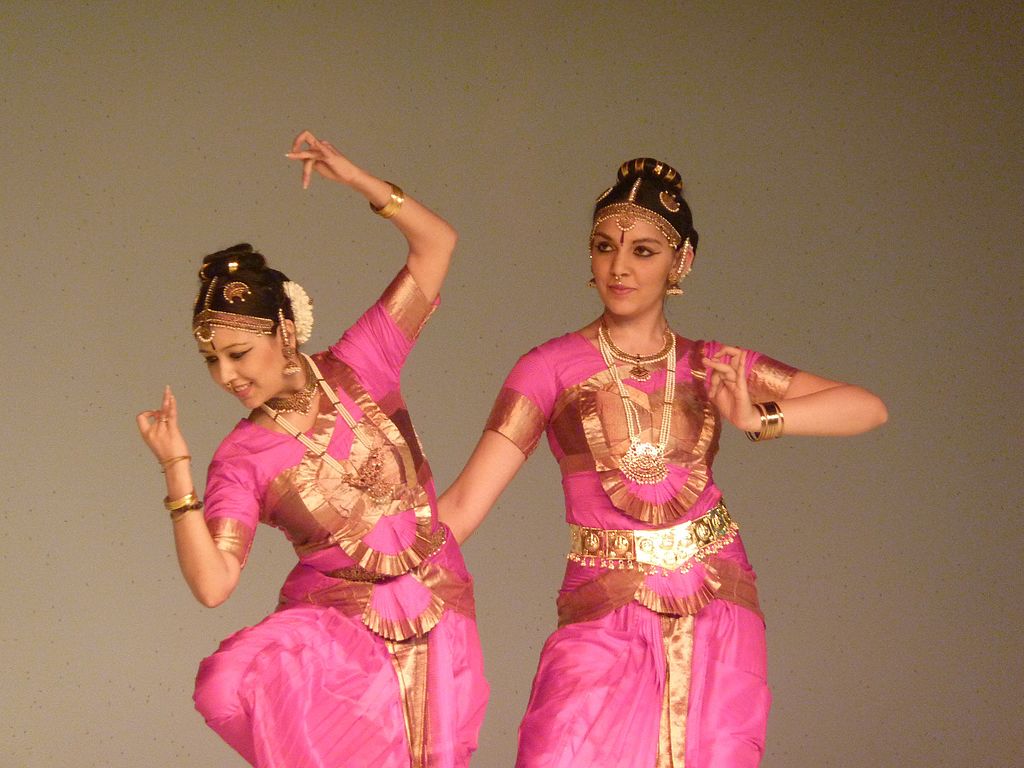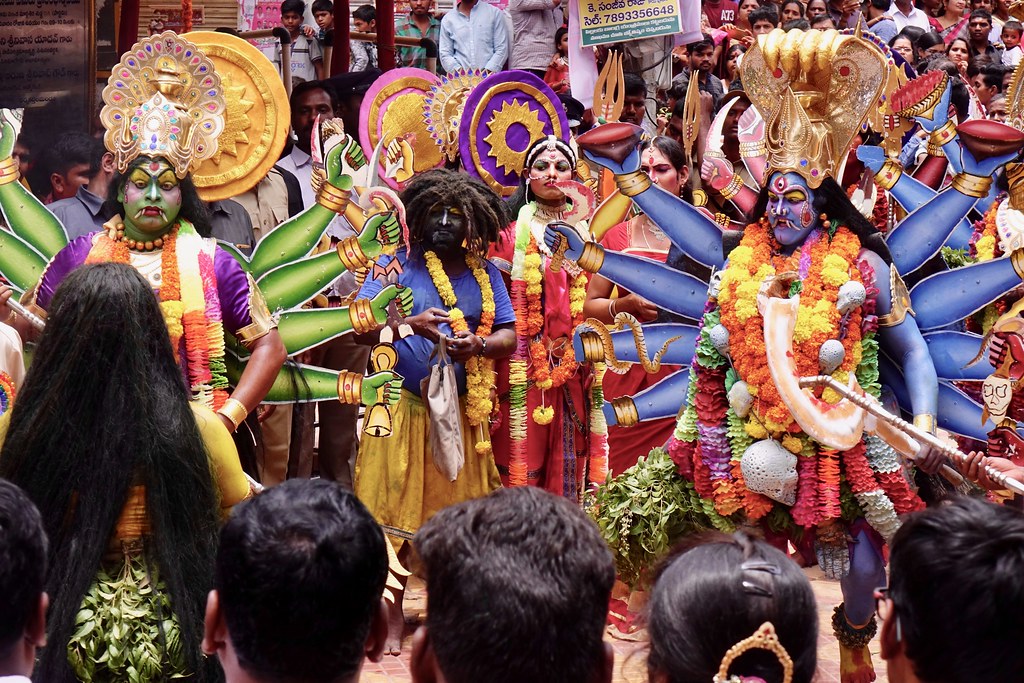
The only Indian state with three capitals – Andra Pradesh is a boon to India. Packed with emerald greenery, soul-soothing rivers and serene temples, the state of Andra Pradesh lies on the southeastern coast of India. While it is widely known for its rice agriculture (also known as the ‘rice bowl of India’), Andra Pradesh is also well stocked with plenty of indigenous art and culture. The traditional dances of this state are highly regarded and are performed in several parts of India. Below listed are a few popular dances prevalent in Andra Pradesh that will make you fall in love with the state:
1. Kuchipudi

One of the 8 classical dances in India, Kuchipudi originated from the ancient text of Natya Shastra. The dancers are adorned with lovely, colorful jewelry and a traditional saree. The dance is pleasant to watch and contains both fast and slow movements. Along with vocals, the dance also consists of several instruments to create a musical sound, such as the veena or violin, the mridangam, and a cymbal player. Kuchipudi mainly plays the role of alerting people about the evil powers that exist in the world. Interestingly, it is said that Kuchipudi gets its name from a village with the same name.
2. Veeranatyam

Also known as Veerangam and Veerabhadra Nriyatam, this dance form is performed as a tribute to Lord Shiva. The men in this performance maintain complex and fierce positions to honor the incarnation of Lord Shiva, Veerabhadra. The interesting story behind the roots of this dance goes back to when Sati was humiliated by her father, Daksha. Legend says that after she sacrificed herself, Lord Shiva arose, furious and agonized, and gave birth to two forms; one of which was Veerbhadra. The birth of the two forms was followed by widespread destruction and loss. It is said that the descendants of Veerbhadra carry on this age-old dance to date. The dancers skillfully display the fury and tsunami of emotions that Lord Shiva felt after the death of his beloved.
3. Burra Katha

A form of theatrical performance, Burra Katha is a narrative that includes dance, dialogues, poems, music, jokes, etc. The main idea behind the performance is to showcase the devotion of the dancers towards their God. It usually contains 3-4 dancers with only one (main) storyteller. To aid the music, the dancers play tambura and veena extensively throughout the performance. Originally done as a pastime in villages, Burra Katha now is also seen during festivals such as Diwali and Sankranti.
4. Andra Natyam

Andra Natyam is a dance form that was discovered about 2000 years back. Similar to Bharat Natyam, this dance form focuses more on the foot movements and facial expressions of the dancer. Due to its purity and sanctity, Andra Natyam is usually performed by temple dancers and it makes use of several musical instruments such as the veena, tanpura, manjira, and surpeti. Although this exquisite dance form was on the road to decline during the Mughal reign, it was fortunately revived in the 20th century. Both men and women can perform this dance.
5. Vilasini Natyam

This special dance is solely for the Telugu Devdasis. In simple terms, a devdasi is a woman who is married to the temple deity and is considered especially auspicious. The devdasis danced in the courts of kings for entertainment and to educate the people. They used dance, to convey music and knowledge of literature to people. In another instance, they would also perform for the illiterate audience and convey the knowledge and stories from the Hindu scriptures. This dance form was heavily scrutinized during the British raj and was condemned, however, people are now gradually reviving and honoring the Vilasini Natyam for its grace and beauty.
6. Butta Bommalu

The epitome of color and joy, this dance form truly mesmerizes its audience. Butta Bommalu correctly means ‘basket toys’ or ‘dance of masks’ because this folk dance uses life-sized toy-like costumes, which are hollow from the inside. Wearing big, colorful clothing, the dance does not make use of sound. The performers simply imitate the characters, causing raging curiosity amongst their audience. Butta Bommalu essentially celebrates happiness during festivals. Therefore, the costumes usually vary depending on what festival it is. For example, the costumes of Hanuman, Parvati, Lord Shiva, and Ram are most likely to be seen.
7. Lambadi

The number of fascinating tribal communities in India will leave you awestruck! And to know about their cultures and traditions is cherry on top! The Lambadi dance is the folk dance of the Banjara community of Andra Pradesh. It is mainly done to celebrate and praise the Lord for a good harvest. While women are known to perform this tribal dance, men aren’t restricted to take part. Furthermore, the heavily embroidered clothing and heavy brass ornaments worn by the performers add to the beauty of this dance.
8. Kolattam

Known as the ‘Stick Dance’, Kolattam is prevalent in several parts of India with different names. The history behind the origins of this village dance form is highly interesting. The story follows the vicious and malevolent demon Basavasura who reaped havoc in the village. One day a group of girls performed the Kolattam dance routine in front of the asur. Basavasura was so enchanted by the graceful dance that he quickly relinquished his abhorrence. Moreover, it is also said that Basavasura was an incarnation of Lord Shiva, the destroyer. The beauty of the dance is enhanced by the bright-colored skirts of the dancers. They wear lovely jewelry and synchronize their footsteps to form a splendid dance pattern. Truly a treat for the eyes!
9. Dappu

Dappu is the traditional form of percussion instruments. It uses a very simplistic drumming instrument. It is an integral part of many folk forms of performing arts and folk dances, especially the Dappu folk dance. Made of goatskin, a tambourine-like drum is struck with sticks producing a rhythm that is softened by the ankle bells that the 16 to 20 dancers wear. Dappu dancers are at the front of any procession, whether it be for jataras, festivals or marriages, this is truly a celebration of the percussive powers of dance. This invigorating art form hails from Nizamabad District. The performers in colourful make-up and even more eccentric costumes dance to the musical patterns set by cymbals, tabla and a harmonium. Mythological themes are usually enacted and the audience is rural folk.
10. Dhimsa

Dhimsa is a dance which does not discriminate and is suitable for people of ages from the Valmiki, Bagata, Khond and Kotia clans – dwelling in the charming Araku Valley in the hilly stretches of the Vishakhapatam area. Tribals perform this dance during the months of Chaitra i.e March/April, at weddings and different events. During the celebrations, artists of one village visit the other to participate in the dance and join the community feast. Such is known as the “Sankidi Kelbar”. A remarkable aspect of the Dhimsa dance is that it encourages friendship and fraternity between individuals of various regions. This being traditionally an ancestral dance, womenfolk are attired in common ancestral dress and adornments and dance in gatherings to the tune of Mori, Kiridi, Tudumu, Dappu and Jodukommulu.
11. Tappeta Gullu

Tappeta Gullu is a devotional dance of Andhra Pradesh common in the districts of Srikakulam, Vizianagaram and Vishakhapatnam. During ancient times it was performed by cowherds and shepherds to entertain the Rain Goddess, Gangamma. At present, the dance is performed in all village festivals celebrated in honour of the deity. The vigour, rhythm and tempo of Tappeta Gullu is exceptional. The songs that are sung throughout the Tappeta Gullu dance are mostly in praise of Lord Vishnu. Tappeta Gullu is performed by a group of twelve to thirty men, who are dressed in a shirt, a turban and a loincloth. They also wear ankle bells. The performers of the dance are accompanied by Tappeta or gundlu, hung on the chest. It is a musical instrument comparable to a drum. The dance of Tappeta Gullu requires tremendous skill and muscle power. A vital characteristic of the dance is that while dancing the artists display rare skills in acrobatics. While performing, the dancers stand one above the other on the thighs and shoulders of each other and form the shape of a gopuram or a tree.
12. Bonalu

Bonalu began as a harvest feast gradually progressing into a procession dance. It is one of the folk festivals prevalent in the Telangana region of Andhra Pradesh. Celebrated in the month of Aashadha, according to the Hindi calendar, (which falls in the month of June or July) this festival is predominantly seen among Hindus. An intriguing thing about Bonalu is that women participate in the procession carrying ‘Ghatams’ or ornamented pots filled with flowers on their heads. The women devotees also carry brass vessels or clay pots filled with cooked rice and adorned with neem leaves. In the procession, men accompany the women devotees by playing the drums and go to worship the local deity. Dressed in multicoloured dresses they balance the pots to the rhythmic songs and tunes, sung in glorifying the village deity Mahankali. The male dancers are known as Potharajus, lead the procession by lashing whips and neem leaves.
It is rightly said by our forefathers that dance is the language of the soul. Performed for thousands of years, these folk dances speak of ancient cultures and traditions which have been carefully preserved and treasured. These dance forms and folk arts form an integral part of our identity. By knowing these traditions, we can know what our age-old culture holds for us. We need to carry these dance forms forward and pass this gold on from generation to generation. After all, we owe it to our forefathers, don’t we?






Very informative and beautifully written!
Thanks Sanika 🙂
Good job and Thanks for sharing.
Thanks 🙂
Every tradition has something unique. This is our india,
Well said Samas, Thanks 🙂